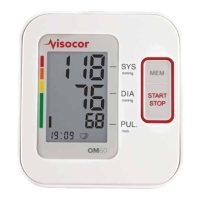
Do you have a question about the uebe visocor OM60 and is the answer not in the manual?
| Device Type | Upper Arm Blood Pressure Monitor |
|---|---|
| Measurement Method | Oscillometric |
| Cuff Size | 22-42 cm |
| Arrhythmia Detection | Yes |
| Irregular Heartbeat Detection | Yes |
| Measurement Range (Pressure) | 0-280 mmHg |
| Automatic Shut-off | Yes |
| Accuracy (Pressure) | ±3 mmHg |
| Accuracy (Pulse) | ±5% |
| Power Supply | 4 x AA batteries or AC adapter |
| Memory | 60 measurements |
| Measurement Range (Pulse) | 40-199 bpm |
Explains the device's primary function for adults and its use by healthcare professionals.
Key safety guidelines for patient use, including warnings and precautions for children and specific conditions.
Technical specifications and requirements for safe operation, including handling and power supply.
Crucial warnings regarding device handling, children, pets, and potential hazards to avoid injury.
Identifies and explains the different parts and components of the blood pressure monitor.
Explains the various symbols and readings shown on the device's digital display.
Provides essential guidance for accurate measurements, including preparation and environmental factors.
Steps for setting up the device for the first time, including battery insertion and initial operation.
Detailed instructions on how to change batteries and understand the battery indicator.
Guide on how to correctly set the date and time on the device for accurate record-keeping.
Instructions on how to properly position and secure the blood pressure cuff on the arm.
Explains the correct posture for obtaining accurate blood pressure readings.
Step-by-step guide on how to perform a blood pressure measurement.
Explains how blood pressure readings are classified according to WHO/ISH guidelines.
Describes the symbol indicating irregular pulses and how to interpret it.
Details on how to retrieve, view, and delete stored measurement data.
Explains the meaning of systolic and diastolic pressure in blood circulation.
Discusses factors influencing blood pressure variations and measurement differences.
Emphasizes the importance of regular measurements for accurate health assessment.
Lists common error codes, their possible causes, and corrective actions.
Provides contact information for support and authorized repair services.
Lists detailed specifications of the device, including range, power, and dimensions.
Information on recommended spare parts and accessories for the device.
Guidelines for periodic metrological inspection and calibration of the device.
Defines various symbols used on the device and in the manual.
Instructions on how to properly dispose of the device and batteries.
Information regarding EMC compliance and precautions.
Details on EMC immunity and recommended separation distances for RF equipment.
Information on electromagnetic emissions and separation distances for RF equipment.
Instructions for proper cleaning, handling, and upkeep of the device.
Outlines the warranty period, coverage, exclusions, and claim procedures.